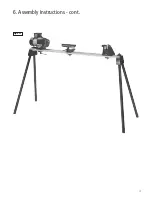
9
KINEMATIC DESIGN
Throughout this manual you will find references to kinematics and the
kinematic design of this product. The principle of kinematics is that three points of
contact provide the most stability. The best example of this is to compare the stability
of a three legged stool and four legged stool. The three legged stool utilises the
kinematic concept and will never rock because it has three points of contact. The four
legged stool however is far more unstable, only a tiny amount of distortion will cause
the stool to become unstable and move. Record Power apply the kinematic design
theory to the CL3-CAM and CL4-CAM lathes, wherever there is a critical piece of the
structure being assembled kinematics are employed giving unsurpassed stability and
rock solid performance. Please take care to follow all instructions when assembling,
making sure that all critical kinematic areas are correctly positioned so that you enjoy
optimum performance.
i
Kg
5. Specifications
Maximum distance between centres:
36” (914 mm)
Maximum bowl diameter over bed:
9” (229mm)
Maximum bowl diameter with DML-BR fitted:
12” 305 mm)
Maximum spindle diameter:
6” 152 mm)
Pulley speeds:
450, 950, 1500 & 2000 rpm
Spindle nose:
3/4” x 16 tpi
Motor power:
1/ 3 hp (250 W)
Depth:
305 mm
Width:
1295 mm
Height:
298 mm
Weight:
40 kg
Noise emission:
Sound power level < 85 dB (A)
Sound pressure level < 85 dB (A)
HEADSTOCK SPINDLE AND TAILSTOCK BARREL BORED TO SUIT NO.1 MORSE TAPER SHANK.
SPINDLE FLATTED TO SUIT 9/16" WHITWORTH WRENCH TO FACILITATE FITTING AND RELEASE OF SPINDLE NOSE
ATTACHMENTS SUPPLIED. SPINDLE THREAD 3/4" X 16 TPI WHITWORTH THREAD.
Pulley Speed Ranges
By changing the belt on to each of the four pulleys, the speed can be varied from 450 to 2000 rpm.
Spindle Pulley
450
rpm
950
rpm
1500
rpm
2000
rpm
Motor Pulley































